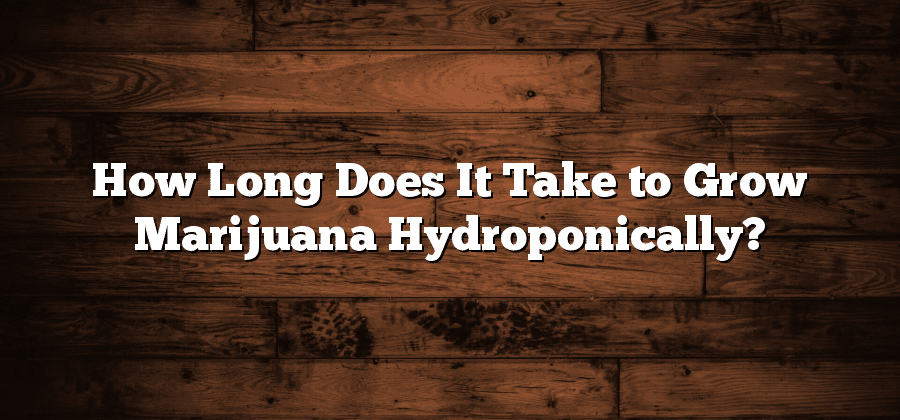Factors affecting the growth speed of hydroponic marijuana
Factors affecting the growth speed of hydroponic marijuana can be influenced by various factors. One significant factor is the quality of nutrients provided. Hydroponic systems rely on the use of nutrient solutions to provide essential elements for plant growth. However, if the nutrient solution is not properly balanced or lacks certain nutrients, it can hinder the speed at which marijuana plants grow. Therefore, it is essential for hydroponic cultivators to carefully monitor and maintain the nutrient solution to ensure optimal growth.
Another factor that can impact the growth speed of hydroponic marijuana is the pH level of the nutrient solution. Marijuana plants thrive in a slightly acidic environment, with a pH level between 5.5 and 6.5. When the pH level deviates from this range, it can negatively impact nutrient uptake and overall plant health. To maintain the ideal pH level, hydroponic growers regularly monitor the pH of their nutrient solution and make necessary adjustments using pH regulators. By ensuring the pH is within the optimal range, cultivators can promote faster growth and healthier plants.
Germination stage in hydroponic marijuana cultivation
During the germination stage, the process of seed activation and the emergence of the seedling takes place in hydroponic marijuana cultivation. This stage is crucial for the overall success of the cultivation process, as it sets the foundation for the plant’s growth and development. Proper care and attention during this stage can greatly improve the chances of a successful harvest.
One of the key factors to consider during germination is the moisture level of the growing medium. The seeds should be placed in a moist environment to encourage optimal sprouting. However, it is important to ensure that the medium is not overly saturated, as this can lead to oxygen deprivation and may cause the seeds to rot. Additionally, maintaining a consistent temperature, ideally around 70 to 85 degrees Fahrenheit (21 to 29 degrees Celsius), can promote quicker and more uniform germination. Providing a suitable light source, such as fluorescent or LED lights, can also stimulate the germination process.
Vegetative stage and its duration in hydroponic marijuana growth
The vegetative stage is a crucial period in the growth of hydroponic marijuana plants. During this stage, the plants focus on developing a strong root system and producing ample foliage. This phase can last anywhere from two to eight weeks, depending on various factors such as strain genetics, nutrient availability, and environmental conditions.
Since the vegetative stage is characterized by rapid growth, it is essential to provide the plants with optimal conditions. Providing a balanced nutrient solution that contains adequate amounts of nitrogen is crucial for promoting healthy leaf and stem development. Additionally, maintaining a stable temperature and humidity level, typically around 70-80°F (21-27°C) and 50-70% humidity, respectively, helps ensure optimal growth and minimize the risk of pest and disease infestations.
Proper training techniques, such as topping or pruning, can also be employed during this stage to control the plant’s shape and promote bushier growth. By carefully managing these factors during the vegetative stage, cultivators can set the foundation for a successful and productive hydroponic marijuana cultivation.
Flowering stage and its timeline in hydroponic marijuana cultivation
At the flowering stage, hydroponic marijuana plants begin to develop buds that eventually lead to the production of flowers. This stage is crucial for obtaining high-quality yields and optimal potency. The timeline for the flowering stage in hydroponic marijuana cultivation can vary depending on the strain and growing conditions. Generally, it ranges from 8 to 12 weeks, with some varieties taking even longer.
During this stage, it is important to closely monitor the plants for any signs of stress or nutrient deficiencies. The flowering stage requires careful attention to light and temperature conditions to ensure successful bud development. Providing the right balance of nutrients and maintaining the ideal environment will encourage the plants to produce large, resinous flowers. Additionally, proper pruning and training techniques can be implemented to optimize the flowering process, resulting in higher yields and better overall quality.
Optimal light and temperature conditions for hydroponic marijuana growth
One of the key factors in successfully growing hydroponic marijuana is providing the optimal light and temperature conditions. Light plays a crucial role in the growth and development of the plant, as it is essential for photosynthesis. In a controlled indoor environment, growers typically use artificial lighting systems such as high-intensity discharge (HID) lamps or light-emitting diodes (LEDs) to provide the necessary light spectrum for the plants. The duration of light exposure also needs to be carefully regulated, as marijuana plants have specific light requirements during different stages of growth.
Temperature is another vital factor to consider when creating the optimal growing conditions for hydroponic marijuana. The ideal temperature range for most marijuana strains is between 70-85°F (21-29°C) during the day and around 10-15°F (5-10°C) cooler at night. These temperature ranges promote healthy growth and prevent the plants from experiencing stress. It is important to ensure that the temperature remains consistent and does not fluctuate too much, as sudden temperature changes can negatively impact the plants and hinder their growth. Additionally, maintaining proper ventilation and air circulation within the growing space helps control temperature and humidity levels, creating an optimal environment for hydroponic marijuana cultivation.






